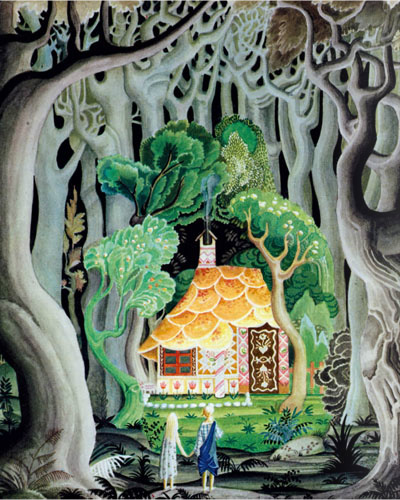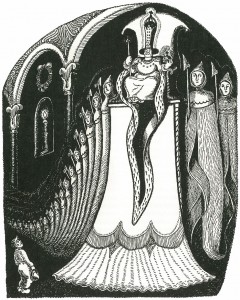There is no dearth of Grimm tales in children’s literature. In fact, Grimm was children’s literature for many years in the 19th century. What is fascinating is not the pervasiveness of the Brothers Grimm, but in the countless adaptations of their tales. Even the brothers themselves modifed the text in many instances, publishing mulitple versions of the same story within their lifetimes. As scholars, linguists, and archivists, their original intended audience was not primarily children but adults; they wished to chronicle the local, and in many cases oral storytelling of the German republic, and if a frog prince got hurled against a wall (instead of kissed) to break a spell, who would raise an eyebrow? Nevertheless, even their ‘PG’ versions were surprisingly and rather inventively violent, especially if you had the misfortune of being a stepsister, or stepmother. Apparently, blended families were the ticket to severe bodily injury, and occasionally a very painful death, which puts a whole new spin to the Brady Bunch when you think about it.
Now comes this new translation by Matthew Price, The Fairy Tales of the Brothers Grimm, a compendium of familiar and not so familiar stories in their original 1857 form: warts, revenge and all. Noel Daniel, the editor of this impressive tome does something quite unusual by casting the spotlight on the illustrators who helped to bring these fairy tales into the collective consciousness. Each of the 27 tales, in the order of when they originally appeared, are paired with some of the most influential illustrators of the 1820’s to the 1950’s. It would have been nice to see a few contemporary artists, like Lisbeth Zwerger, who is surely the most gifted visual interpreter of Grimm in the last fifty years, included alongside the roster of ‘famous’ illustrators, but this is a minor quibble. The Fairy Tales of the Brothers Grimm is beautiful, wicked fun.
The best pairing in the book is The Fisherman and His Wife, with illustrations by Wanda Gág from a 1936 adaptation of the story. As things happen in fairy tales, a fisherman reels in an enchanted fish, who is actually a prince. I have heard of bewitched frogs, but never a bewitched flounder. In any case, the fish pleads for his life, and the fisherman lets him go. The fisherman’s shrewish wife, however, does not share her husband’s generosity of heart, and instead sees the flounder that laid a golden egg. “You mean you didn’t wish for anything?” Off goes the fisherman to demand a ‘cute little cottage’ in return for the prince’s life. Perpetually dissatisfied, the wife makes her husband return to the flounder over and over again, each time demanding greater wealth and power. Turns out being emperor, king or even Pope isn’t all that much fun, in spite of the awesome headgear. Might as well be God. Of course, this doesn’t end well. Be careful what you wish for…and never, ever look a gift-flounder in the mouth.
The accompanying drawings by Wanda Gág belie their age, unlike some of the other artwork. The illustrations are as fresh and as witty as anything being produced by the current crop of top-tier illustrators, which is kind of a revelation. Further investigation of this talented artist is required, and happily there is a extensive biography of Gág and all of the illustrators in the back of The Fairy Tales of the Brothers Grimm.
Born in 1893, the eldest daughter of an immigrant German-Bohemian family, Gág is perhaps best known for her Newbery-honor book Millions of Cats, which has never been out of print since its publication in 1928. Other familiar names include George Cruikshank, Kay Nielsen, and the great Arthur Rackham, who contributes a lovely owl for Jorinda and Joringel, and silhouettes for several other tales. Some names were completely new to me, as were the stories and the illustrations. Gustaf Tenggren, for instance, a Swedish illustrator who later emigrated to the US, brings a loopy sensibility to the collection. His illustrations for The Devil With the Three Golden Hairs have a kind of hillbilly menace, which is also evident in his later work as art director for Disney’s Snow White and the Seven Dwarfs (backgrounds mostly, although there is definitely something menacing about those Dwarfs.) Noel Daniel does an excellent job placing all of the illustrators within their historical context, from the dawning of the illustrated children’s book in the 19th century to the Grimmification of popular culture the 20th and 21st century:
“What began as an attempt to collect German tales for posterity has become a cultural treasure belonging to all of us, and a potent, ceaseless source of inspiration for generations of writers, artists, and filmakers around the world.”
And you thought it was all about vampires…
The publisher, Benedikt Taschen of Germany, should be congratulated for making the leap into children’s literature with The Fairy Tales of the Brothers Grimm. Previously, they were known for the breadth of their reasonably priced art publications, many of which reside on my bookshelves, and porn. I suppose the latter category is in the eye of the beholder, but consider if you will, their other major publication this fall-The Big Book of Pu*** (not to be confused…in any way…with the Puss in Puss ‘n Boots.) As a former bookseller, I can tell you that the arrival of the Taschen catalogue was greeted with considerably more interest than say…Penguin, especially by the shippers. Go figure.
After graduating from Princeton with a degree in German languages and literature, Noel Daniel studied media history in Berlin on a Fulbright Scholarship. She lives in Los Angeles.
Matthew Price has translated for leading theatres and publications in Germany and the US. He is also a graduate from Princeton University. Mr Price lives in New York city.
The Fairy Tales of the Brothers Grimm, edited by Noel Daniel, newly translated by Matthew Price with Noel Daniel. Published by Taschen, 2011. ISBN: 978-3836526722




